| Listing 1 - 7 of 7 |
Sort by
|
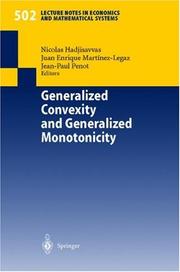
ISBN: 3642566456 3540418067 Year: 2001 Volume: 502 Publisher: Berlin Springer
Abstract | Keywords | Export | Availability | Bookmark
 Loading...
Loading...Choose an application
- Reference Manager
- EndNote
- RefWorks (Direct export to RefWorks)
Convex functions --- Monotonic functions --- Geometry --- Operational research. Game theory --- Mathematical optimization. --- Operations research. --- Decision making. --- Calculus of variations. --- Optimization. --- Operations Research/Decision Theory. --- Calculus of Variations and Optimal Control; Optimization. --- Isoperimetrical problems --- Variations, Calculus of --- Maxima and minima --- Deciding --- Decision (Psychology) --- Decision analysis --- Decision processes --- Making decisions --- Management --- Management decisions --- Choice (Psychology) --- Problem solving --- Operational analysis --- Operational research --- Industrial engineering --- Management science --- Research --- System theory --- Optimization (Mathematics) --- Optimization techniques --- Optimization theory --- Systems optimization --- Mathematical analysis --- Operations research --- Simulation methods --- System analysis --- Decision making

ISBN: 3540409521 3540412212 9783540412212 Year: 2001 Volume: 1629 Publisher: Berlin New York Hong Kong Springer
Abstract | Keywords | Export | Availability | Bookmark
 Loading...
Loading...Choose an application
- Reference Manager
- EndNote
- RefWorks (Direct export to RefWorks)
Riemannian, symplectic and complex geometry are often studied by means ofsolutions to systems ofnonlinear differential equations, such as the equa tions of geodesics, minimal surfaces, pseudoholomorphic curves and Yang Mills connections. For studying such equations, a new unified technology has been developed, involving analysis on infinite-dimensional manifolds. A striking applications of the new technology is Donaldson's theory of "anti-self-dual" connections on SU(2)-bundles over four-manifolds, which applies the Yang-Mills equations from mathematical physics to shed light on the relationship between the classification of topological and smooth four-manifolds. This reverses the expected direction of application from topology to differential equations to mathematical physics. Even though the Yang-Mills equations are only mildly nonlinear, a prodigious amount of nonlinear analysis is necessary to fully understand the properties of the space of solutions. . At our present state of knowledge, understanding smooth structures on topological four-manifolds seems to require nonlinear as opposed to linear PDE's. It is therefore quite surprising that there is a set of PDE's which are even less nonlinear than the Yang-Mills equation, but can yield many of the most important results from Donaldson's theory. These are the Seiberg-Witte~ equations. These lecture notes stem from a graduate course given at the University of California in Santa Barbara during the spring quarter of 1995. The objective was to make the Seiberg-Witten approach to Donaldson theory accessible to second-year graduate students who had already taken basic courses in differential geometry and algebraic topology.
Global analysis (Mathematics) --- Four-manifolds (Topology) --- Mathematical Theory --- Geometry --- Mathematics --- Physical Sciences & Mathematics --- Analyse globale (Mathematiques) --- Globale analyse (Wiskunde) --- Trois-variétés (Topologie) --- Vier-menigvuldigheden (Topologie) --- Analyse globale (Mathématiques) --- Variétés topologiques à 4 dimensions --- Algebra. --- Algebraic topology. --- Calculus of variations. --- Global analysis (Mathematics). --- Manifolds (Mathematics). --- System theory. --- Algebraic geometry. --- Algebraic Topology. --- Calculus of Variations and Optimal Control; Optimization. --- Global Analysis and Analysis on Manifolds. --- Systems Theory, Control. --- Algebraic Geometry. --- Algebraic geometry --- Systems, Theory of --- Systems science --- Science --- Geometry, Differential --- Topology --- Analysis, Global (Mathematics) --- Differential topology --- Functions of complex variables --- Geometry, Algebraic --- Isoperimetrical problems --- Variations, Calculus of --- Maxima and minima --- Mathematical analysis --- Philosophy
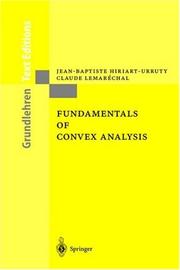
ISBN: 3540422056 3642564682 9783540422051 Year: 2001 Publisher: Berlin: Springer,
Abstract | Keywords | Export | Availability | Bookmark
 Loading...
Loading...Choose an application
- Reference Manager
- EndNote
- RefWorks (Direct export to RefWorks)
This book is an abridged version of our two-volume opus Convex Analysis and Minimization Algorithms [18], about which we have received very positive feedback from users, readers, lecturers ever since it was published - by Springer-Verlag in 1993. Its pedagogical qualities were particularly appreciated, in the combination with a rather advanced technical material. Now [18] hasa dual but clearly defined nature: - an introduction to the basic concepts in convex analysis, - a study of convex minimization problems (with an emphasis on numerical al- rithms), and insists on their mutual interpenetration. It is our feeling that the above basic introduction is much needed in the scientific community. This is the motivation for the present edition, our intention being to create a tool useful to teach convex anal ysis. We have thus extracted from [18] its "backbone" devoted to convex analysis, namely ChapsIII-VI and X. Apart from some local improvements, the present text is mostly a copy of the corresponding chapters. The main difference is that we have deleted material deemed too advanced for an introduction, or too closely attached to numerical algorithms. Further, we have included exercises, whose degree of difficulty is suggested by 0, I or 2 stars *. Finally, the index has been considerably enriched. Just as in [18], each chapter is presented as a "lesson", in the sense of our old masters, treating of a given subject in its entirety.
Convex sets. --- Convex functions --- Convex sets --- Mathematical analysis --- Computers. --- Mathematical analysis. --- Analysis (Mathematics). --- Calculus of variations. --- Operations research. --- Management science. --- System theory. --- Theory of Computation. --- Analysis. --- Calculus of Variations and Optimal Control; Optimization. --- Operations Research, Management Science. --- Systems Theory, Control. --- Systems, Theory of --- Systems science --- Science --- Quantitative business analysis --- Management --- Problem solving --- Operations research --- Statistical decision --- Operational analysis --- Operational research --- Industrial engineering --- Management science --- Research --- System theory --- Isoperimetrical problems --- Variations, Calculus of --- Maxima and minima --- 517.1 Mathematical analysis --- Automatic computers --- Automatic data processors --- Computer hardware --- Computing machines (Computers) --- Electronic brains --- Electronic calculating-machines --- Electronic computers --- Hardware, Computer --- Computer systems --- Cybernetics --- Machine theory --- Calculators --- Cyberspace --- Philosophy --- Analyse convexe --- Programmation mathematique --- Programmation convexe
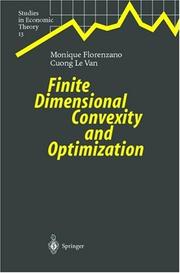
ISBN: 3540415165 3642625703 3642565220 9783540415169 Year: 2001 Volume: 13 Publisher: Berlin: Springer,
Abstract | Keywords | Export | Availability | Bookmark
 Loading...
Loading...Choose an application
- Reference Manager
- EndNote
- RefWorks (Direct export to RefWorks)
The primary aim of this book is to present notions of convex analysis which constitute the basic underlying structure of argumentation in economic theory and which are common to optimization problems encountered in many applications. The intended readers are graduate students, and specialists of mathematical programming whose research fields are applied mathematics and economics. The text consists of a systematic development in eight chapters, with guided exercises containing sometimes significant and useful additional results. The book is appropriate as a class text, or for self-study.
Operational research. Game theory --- Convex functions --- Mathematical optimization --- Applied mathematics. --- Engineering mathematics. --- Economic theory. --- Operations research. --- Decision making. --- Calculus of variations. --- Applications of Mathematics. --- Economic Theory/Quantitative Economics/Mathematical Methods. --- Operations Research/Decision Theory. --- Calculus of Variations and Optimal Control; Optimization. --- Isoperimetrical problems --- Variations, Calculus of --- Maxima and minima --- Deciding --- Decision (Psychology) --- Decision analysis --- Decision processes --- Making decisions --- Management --- Management decisions --- Choice (Psychology) --- Problem solving --- Operational analysis --- Operational research --- Industrial engineering --- Management science --- Research --- System theory --- Economic theory --- Political economy --- Social sciences --- Economic man --- Engineering --- Engineering analysis --- Mathematical analysis --- Decision making --- Mathematics

ISBN: 079237827X 140200611X 0387334513 9780792378273 Year: 2001 Publisher: Boston: Kluwer Academic Publishers,
Abstract | Keywords | Export | Availability | Bookmark
 Loading...
Loading...Choose an application
- Reference Manager
- EndNote
- RefWorks (Direct export to RefWorks)
The goal of the Encyclopedia of Operations Research and Management Science is to provide decision makers and problem solvers in business, industry, government and academia with a comprehensive overview of the wide range of ideas, methodologies, and synergistic forces that combine to form the pre-eminent decision-aiding fields of operations research and management science (OR/MS). The Second Edition is a further extension of this goal - which through addressing and solving a wide range of problems - OR/MS methodologies continue to flourish and grow. This is a field that is used extensively throughout the applied sciences, and, because of this, the new edition has added topics in the following areas: Analytic Network Process; Call Centers; Certainty Equivalence; Comb. Optimization by Simulated CE; Computational Organization; Constraint Programming; Data Mining; Degeneracy Graphs; Economic Order Q Extensions; Educational Issues in B-Schools; Electronic Commerce; Financial Markets; Global Climate Change; Hidden Markov Models; History of Early British OR; Implementation for Public Sector; Info Tech Benefits; Interactive Multi-Objective Math. Programming; Knapsacks with Nonlinearities; Little's Law in Distribution Form; Military Ops Other than War; Multivariate Quality Control; Perturbation Analysis; Simulation Metamodeling; Simulation Optimization; Supply Chain Management; Theory of Constraints; Timetabling. The intended audience of the Encyclopedia of Operations Research and Management Science is technically diverse and wide; it includes anyone concerned with the science, techniques, and ideas of how one makes decisions. As this audience encompasses many professions, educational backgrounds and skills, we were attentive to the form, format and scope of the articles. Thus, the articles are designed to serve as initial sources of information for all such readers, with special emphasis on the needs of students. Each article provides a background or history of the topic, describes relevant applications, overviews present and future trends, and lists seminal and current references. To allow for variety in exposition, the authors were instructed to present their material from both research and applied perspectives. The Encyclopedia has been organized into specific topics that collectively encompass the foundations, applications, and emerging elements of this ever-changing field. We also wanted to establish the close associations that OR/MS has maintained with other scientific endeavors, with special emphasis on its symbiotic relationships to computer science, information processing, and mathematics. Based on our broad view of OR/MS, we commissioned 228 major expository articles and complemented them by numerous entries: descriptions, discussions, definitions, and abbreviations. The connections between topics are highlighted by an entry's final `See' statement, as appropriate. Each topical article provides a background or history of the topic, describes relevant applications, overviews present and future trends, and lists seminal and current references. Of significant importance is that each contributed topic has been authored by a leading authoritative researcher on that particular topic.
Operational research. Game theory --- Quantitative business analysis --- Business. --- Production management. --- Operations research. --- Decision making. --- Mathematical models. --- Calculus of variations. --- Business and Management. --- Operation Research/Decision Theory. --- Operations Management. --- Calculus of Variations and Optimal Control; Optimization. --- Mathematical Modeling and Industrial Mathematics. --- Isoperimetrical problems --- Variations, Calculus of --- Maxima and minima --- Models, Mathematical --- Simulation methods --- Deciding --- Decision (Psychology) --- Decision analysis --- Decision processes --- Making decisions --- Management --- Management decisions --- Choice (Psychology) --- Problem solving --- Operational analysis --- Operational research --- Industrial engineering --- Management science --- Research --- System theory --- Manufacturing management --- Industrial management --- Trade --- Economics --- Commerce --- Decision making --- Operations research --- 519.8 --- 519.8 Operational research --- Statistical decision --- Planning (firm) --- Mathematical optimization. --- Operations Research/Decision Theory. --- Optimization (Mathematics) --- Optimization techniques --- Optimization theory --- Systems optimization --- Mathematical analysis --- System analysis --- Operations research - Encyclopedias --- Management science - Encyclopedias --- Operations Research and Decision Theory. --- Calculus of Variations and Optimization.
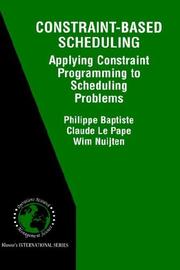
ISBN: 0792374088 1461355745 1461514797 9780792374084 Year: 2001 Volume: 39 Publisher: Boston, Mass.: Kluwer,
Abstract | Keywords | Export | Availability | Bookmark
 Loading...
Loading...Choose an application
- Reference Manager
- EndNote
- RefWorks (Direct export to RefWorks)
Constraint Programming is a problem-solving paradigm that establishes a clear distinction between two pivotal aspects of a problem: (1) a precise definition of the constraints that define the problem to be solved and (2) the algorithms and heuristics enabling the selection of decisions to solve the problem. It is because of these capabilities that Constraint Programming is increasingly being employed as a problem-solving tool to solve scheduling problems. Hence the development of Constraint-Based Scheduling as a field of study. The aim of this book is to provide an overview of the most widely used Constraint-Based Scheduling techniques. Following the principles of Constraint Programming, the book consists of three distinct parts: The first chapter introduces the basic principles of Constraint Programming and provides a model of the constraints that are the most often encountered in scheduling problems. Chapters 2, 3, 4, and 5 are focused on the propagation of resource constraints, which usually are responsible for the "hardness" of the scheduling problem. Chapters 6, 7, and 8 are dedicated to the resolution of several scheduling problems. These examples illustrate the use and the practical efficiency of the constraint propagation methods of the previous chapters. They also show that besides constraint propagation, the exploration of the search space must be carefully designed, taking into account specific properties of the considered problem (e.g., dominance relations, symmetries, possible use of decomposition rules). Chapter 9 mentions various extensions of the model and presents promising research directions.
Constraints (Artificial intelligence) --- 658.513 --- Production scheduling --- 681.3*D1 --- Constraint satisfaction (Artificial intelligence) --- Artificial intelligence --- Job scheduling (Production control) --- Job-shop scheduling --- Project scheduling (Production control) --- Scheduling (Management) --- Production control --- Scheduling --- Supervision of production work. Follow-up, progressing, expediting. Scheduling --- Programming techniques--See also {681.3*E} --- 681.3*D1 Programming techniques--See also {681.3*E} --- 658.513 Supervision of production work. Follow-up, progressing, expediting. Scheduling --- Mathematical optimization. --- Operations research. --- Decision making. --- Computers. --- Calculus of variations. --- Optimization. --- Operations Research/Decision Theory. --- Theory of Computation. --- Calculus of Variations and Optimal Control; Optimization. --- Isoperimetrical problems --- Variations, Calculus of --- Maxima and minima --- Automatic computers --- Automatic data processors --- Computer hardware --- Computing machines (Computers) --- Electronic brains --- Electronic calculating-machines --- Electronic computers --- Hardware, Computer --- Computer systems --- Cybernetics --- Machine theory --- Calculators --- Cyberspace --- Deciding --- Decision (Psychology) --- Decision analysis --- Decision processes --- Making decisions --- Management --- Management decisions --- Choice (Psychology) --- Problem solving --- Operational analysis --- Operational research --- Industrial engineering --- Management science --- Research --- System theory --- Optimization (Mathematics) --- Optimization techniques --- Optimization theory --- Systems optimization --- Mathematical analysis --- Operations research --- Simulation methods --- System analysis --- Decision making
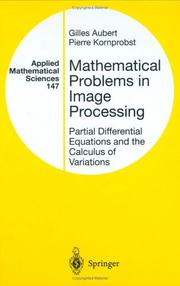

ISBN: 0387953264 9780387953267 9780387217666 9786610189731 1280189738 0387217665 Year: 2001 Publisher: New York (N.Y.) : Springer,
Abstract | Keywords | Export | Availability | Bookmark
 Loading...
Loading...Choose an application
- Reference Manager
- EndNote
- RefWorks (Direct export to RefWorks)
Partial differential equations and variational methods were introduced into image processing about 15 years ago, and intensive research has been carried out since then. The main goal of this work is to present the variety of image analysis applications and the precise mathematics involved. It is intended for two audiences. The first is the mathematical community, to show the contribution of mathematics to this domain and to highlight some unresolved theoretical questions. The second is the computer vision community, to present a clear, self-contained, and global overview of the mathematics involved in image processing problems. The book is divided into five main parts. Chapter 1 is a detailed overview. Chapter 2 describes and illustrates most of the mathematical notions found throughout the work. Chapters 3 and 4 examine how PDEs and variational methods can be successfully applied in image restoration and segmentation processes. Chapter 5, which is more applied, describes some challenging computer vision problems, such as sequence analysis or classification. This book will be useful to researchers and graduate students in mathematics and computer vision.
Image processing --- Mathematics. --- Image processing: image displays image processing software (Computing methododologies) --- 681.3*I4 Image processing: image displays image processing software (Computing methododologies) --- Computers. --- Image processing. --- Mathematical analysis. --- Analysis (Mathematics). --- Applied mathematics. --- Engineering mathematics. --- System theory. --- Calculus of variations. --- Analysis. --- Applications of Mathematics. --- Calculus of Variations and Optimal Control; Optimization. --- Systems Theory, Control. --- Computing Methodologies. --- Image Processing and Computer Vision. --- 681.3*I4 --- 517.97 --- 517.97 Calculus of variations. Mathematical theory of control --- Calculus of variations. Mathematical theory of control --- 681.3*I4 Image processing: image displays; image processing software (Computing methododologies) --- Image processing: image displays; image processing software (Computing methododologies) --- Global analysis (Mathematics). --- Mathematical optimization. --- Systems theory. --- Artificial intelligence. --- Computer vision. --- Artificial Intelligence. --- Optical data processing. --- Optical computing --- Visual data processing --- Bionics --- Electronic data processing --- Integrated optics --- Photonics --- Computers --- AI (Artificial intelligence) --- Artificial thinking --- Electronic brains --- Intellectronics --- Intelligence, Artificial --- Intelligent machines --- Machine intelligence --- Thinking, Artificial --- Cognitive science --- Digital computer simulation --- Logic machines --- Machine theory --- Self-organizing systems --- Simulation methods --- Fifth generation computers --- Neural computers --- Systems, Theory of --- Systems science --- Science --- Isoperimetrical problems --- Variations, Calculus of --- Maxima and minima --- Engineering --- Engineering analysis --- Mathematical analysis --- 517.1 Mathematical analysis --- Optical equipment --- Philosophy --- Mathematics
| Listing 1 - 7 of 7 |
Sort by
|

 Search
Search Feedback
Feedback About UniCat
About UniCat  Help
Help News
News